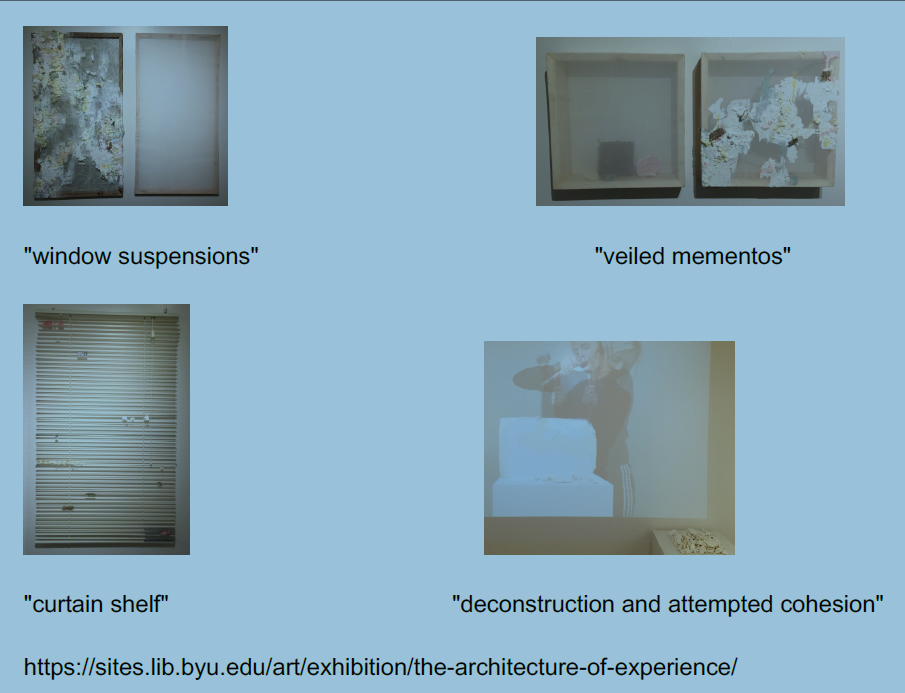Goldrup, Elizabeth Price
The Architecture of Experience
Exploring the relationship between domestic infrastructure and the compartmentalization of experience through art
Faculty Mentor: Joseph Parry, Philososphy
“Your art made me ask questions.” That is what Ari K wrote in the small
book I stationed at my exhibit held in the Harold B Lee Library. When I read this, I
smiled to myself. I proposed to translate the findings of my research about the
relationship between architectural spaces and the psychological compartmentalization
of the experiences had within into the format of contemporary artwork. The result of 26
interviews, consultations with professionals and professors, and many books and
academic journals that balanced disciplines from civil engineering to family sciences
was this show;; six paintings, two sculptures, and a corresponding hour-long video
piece, and sound piece. The aim of transcribing my findings into artwork was to create a
space that would invite the conscious reflection on the themes that I had been
researching. I also hoped to provide a environment in which my own discoveries as well
as still unanswered questions could coexist and continue to reveal themselves.
In my research, I found that the the spaces in which individuals inhabit
have the potential to condition their experiences, in turn encapsulating the emotions,
memories and stages of development in these physical structures. Depending on the
individual and experience, this process of compartmentalization can either provide a
template for personal narrative and psychological organization. Conversely, on the other
end of the spectrum, the confinement of these spaces can lead to the fragmentation of a
narrative, and disrupt one’s sense of cohesion. In my art, I attempted to open a platform
for viewers’ contemplation on the past spaces, both physical and psychological, that
they had inhabited, and discover within themselves their interplay in the individuals’
identity and narrative.
In pieces such as “Window Suspensions,” I employed the metaphor of
building materials to emphasize, as well as neutralize the ingredients of physical
structures. I shuffled the layered components of the interiors of rooms and the internal
components of the walls within a home in order to equalize their visual effect, and
demonstrate the potential for fluidity of importance evoked or bestowed upon spaces. A
common motif, such as appeared in “veiled mementos” was the use of transparent
screen structures. These materials ranged from plexi-glass, curtain lining, window
screen to drop cloth, but they represented an important personal interaction that I had
with my work that I wanted to transfer to others. I wanted to create layers of varying
distances. In creating suspended layers of material that sometimes became a canvas
for new experiences and materials, while other times they separated the viewer from
these things, I communicated my findings on the proximity of memory and the varying
constructs that prevent our interaction with them. In several pieces, I used raw materials
as found. In “curtain shelf” I used a blind that I found to balance various building
elements. In the video piece and accompanying sculpture, “Deconstruction and
attempted cohesion,” I used a brick of plaster to perform what I viewed my role in the
research was at that point.
In my original proposal, I stated that it was important for my findings to be
presented on an artistic platform. The role of art is to provide a forum for sincere
thinkers a space for contemplation and collaboration of ideas. While the results of my
research were often contingent on individuals’ experiences and history, the one unifying
thread was that personal narrative can be clarified through contemplation. Whether we
are being shaped by, or constructing the emotional holding capacities of our physical
environments, we owe ourselves the clarity that engaging in a thoughtful negotiation
with our pasts and the rooms within can offer.

